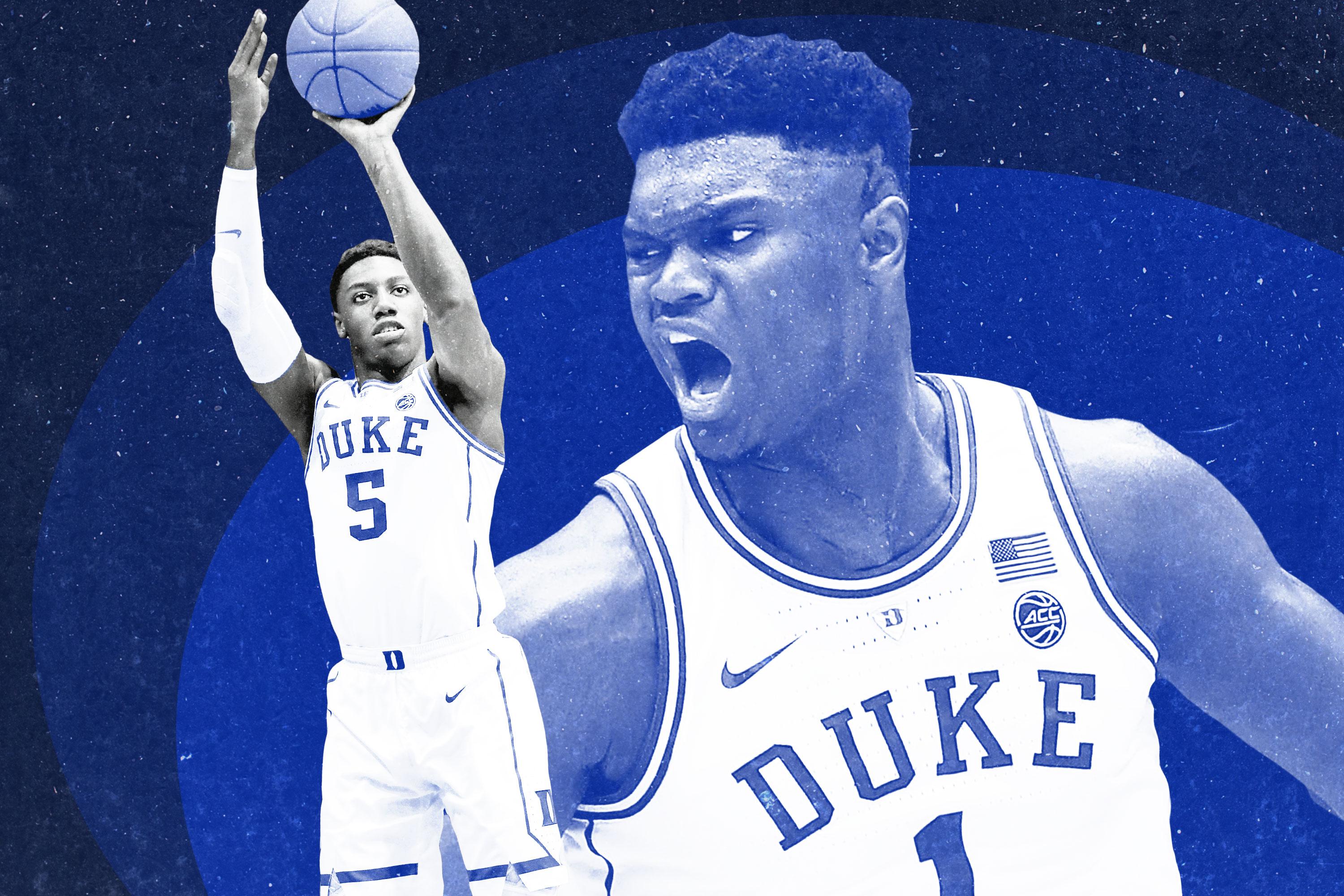R.J. Barrett’s Heroics Aren’t Helping a Duke Team That Doesn’t Need Saving
For the first time in his life, the Canadian prodigy isn’t the best player on his own team. Instead of fighting against that, he can make himself and the Blue Devils better by embracing it.
The torch has been passed at Duke. R.J. Barrett began the season as the front-runner to be the no. 1 overall pick in next year’s NBA draft, but he has been overtaken by fellow freshman Zion Williamson. It’s not just because of Zion’s jaw-dropping physical tools, either. Williamson has displayed a higher basketball IQ and better feel for the game through the first few weeks of the season. He has played a more team-oriented game than Barrett, who has been hunting for his own offense rather than playing within the flow of Coach K’s offense. This season is a great learning opportunity for Barrett, who needs to adjust his approach to reach his potential. This version of Barrett is not helping the Blue Devils win.
Talent is not the issue for Barrett, who is averaging 22.7 points on 42 percent shooting, 6.1 rebounds, and 3.6 assists per game. At 6-foot-7 and 202 pounds with a 6-foot-10 wingspan, the 18-year-old already looks the part of an NBA player. He’s an elite athlete who can get wherever he wants on the court. Barrett is too big and too fast for the vast majority of defenders at the NCAA level: He can blow by them, power through them, or jump over them. All they can do is play off him and dare him to shoot, and he’s making just enough 3s (33.3 percent on 6.0 attempts per game) to keep them honest.
The problem is that he has fallen in love with his shot. He has by far the highest usage rate on the team (36.1) despite being ninth in true shooting percentage (49.1). Barrett is acting like he needs to carry the offense single-handedly when he is playing on one of the most talented teams in the one-and-done era. The most glaring example came in Duke’s 89-87 loss to Gonzaga in the championship of the Maui Invitational tournament last week. Barrett scored 23 points on 9-for-25 shooting, and he went 0-for-5 in the final minute, forcing up difficult shots in traffic and never looking to pass. He shot 36 percent from the field while the rest of his team shot 46.8 percent.
Coach K has had a top-three pick in each of the past five drafts, and none of them dominated the ball as much as Barrett:
Duke Top 3s
There’s no excuse for the way he is playing. While all his predecessors at Duke had at least one other first-round pick on their team, none was playing with a force of nature like Zion. Williamson has been obliterating efficiency records in his first month of NCAA basketball, shooting 72.5 percent from 2-point range on 11.4 attempts per game. There have been too many times early on when Barrett turns him into a bystander. Zion can score or get to the line (5.9 attempts per game) almost every time he touches the ball, yet, unlike R.J., he often opts to move the ball and find the open man rather than force the issue. The team would be better if Barrett followed Williamson’s lead.
Duke has the pieces to be unstoppable on offense. The team’s four marquee freshmen fit together perfectly on paper: a playmaking point guard in Tre Jones, an inside/outside one-two punch in Williamson and Barrett, and a floor spacer and secondary playmaker in Cam Reddish. Everyone else in their rotation can either finish lobs at the rim (juniors Marques Bolden and Javin DeLaurier) or space the defense out to the 3-point line (junior Jack White and sophomore Alex O’Connell). It all comes back to Barrett. He’s a streaky outside shooter whom defenses leave open on the perimeter, so the ball often winds up in his hands, even when one of the other freshmen is initiating. He has to keep it moving.
Barrett isn’t making things easier for his teammates, but the way he’s playing is not doing himself any favors, either. While there isn’t a huge sample size after only seven games, Barrett’s early numbers aren’t encouraging. According to the tracking numbers at Synergy Sports, he’s in the sixth percentile of isolation scorers nationwide and the 27th percentile of pick-and-roll scorers. Most shockingly, considering his freakish combination of size, skill, and athleticism, is that Barrett is in only the 19th percentile of players when finishing around the basket. There are diminishing returns in trying to score through two and three defenders, even for a player as talented as Barrett.
It isn’t like Barrett can’t pass the ball. He can read the floor and make plays on the move, and he has shown the ability to pick apart the defense and find open shooters out of the pick-and-roll. He is averaging 3.6 assists and 2.9 turnovers per game, and he made his name playing as more of a point forward on the international circuit. Barrett led Team Canada to a shocking upset of Team USA in the U19 World Championship last summer, averaging 15.6 field goal attempts and 4.6 assists per game. He alternated between scoring off the dribble and involving his teammates, a style he needs to get back to.
Barrett isn’t as intriguing an NBA prospect if he’s not facilitating. He’s not a good enough shooter to take as many shots as he does. That’s the difference between him and Jayson Tatum, another score-first player at Duke who has blossomed in the NBA. Tatum shot only 34.2 percent from 3 on 4.0 attempts per game in college, but he was an elite free throw shooter, a more reliable predictor of outside shooting in the NBA. Tatum shot 84.9 percent on 4.8 attempts per game at Duke, compared with 62.5 percent on 5.7 attempts for Barrett.
In terms of how he has been playing in college, the better comparison for Barrett among recent Duke products is Jabari Parker. Parker, like Barrett, could score at will off the dribble in the NCAA, but he wasn’t a consistent 3-point shooter or playmaker, issues which have followed him to the next level. Players who hold the ball, don’t space the floor, and don’t create shots for others have a difficult time making their teammates better. To be sure, Parker’s career has also been derailed by injuries, and he was never as good an athlete as Barrett, even before tearing his ACL twice. Barrett should develop into a better two-way player.
Even if Barrett can’t catch Zion in the eyes of NBA executives, he won’t slip far on draft night. No matter where he goes, though, he will have to play well with others. Even the worst teams in the NBA have cornerstones who need the ball to be effective: The Suns have Devin Booker, the Cavs have Kevin Love, the Hawks have Trae Young, the Bulls have Zach LaVine and Lauri Markkanen, and the Knicks have Kristaps Porzingis. None of them will be willing to spot up off a rookie and watch him play like Kobe Bryant. Barrett will have to embrace being part of a team concept on offense, and learn how to play off another ball-dominant player.
Playing at Duke is a unique opportunity for Barrett to grow his game. This is the first time in his life when he isn’t the undisputed best player on his own team. That can be a tough pill to swallow for a teenager, but it can also make him a better player. Barrett doesn’t need to force things as much as he has been through the first seven games. He has done his job once he draws a second defender. Coach K has put so many talented players around Barrett that defenses shouldn’t be able to crowd him when he attacks off the dribble. If he collapses the defense and then moves the ball on to the next man, it will ultimately create more open shots for him, too. The more Williamson and Reddish are scoring, the less willing defenses will be to leave them and guard Barrett.
Barrett is on a legitimate NCAA superteam. In terms of position in the pecking order, he’s is essentially in the same position that Dwyane Wade was when LeBron James came to Miami. Wade was still good enough to be the best player on an elite team, and the Heat would still have won a lot of games if LeBron ceded control to him. They probably wouldn’t have won two straight NBA titles, though. Zion may not be LeBron, but he could become a transcendent player in his own right. The current shot distribution at Duke doesn’t make sense. Barrett is shooting 42 percent from the field on 20.3 field goal attempts per game, while Williamson is shooting 66.7 percent on 12.9 attempts.
The Blue Devils, for as dominant as they have looked at times this season, aren’t invincible. A close loss in November to an elite team like Gonzaga doesn’t necessarily mean anything, but it did reveal some issues that have to be addressed. Duke won’t win an NCAA championship if the Blue Devils don’t get their best player the ball. Barrett has to resist the temptation to take over games by himself. He has to trust his teammates. College basketball is supposed to be a learning experience. His time at Duke could just be a pit stop on his way to the next level, or it could be the next step in his education as a basketball player.

